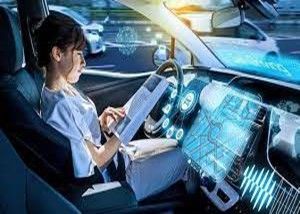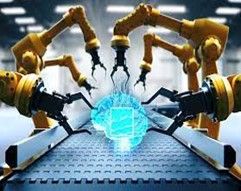AI has revolutionized and significantly improved supply chain management through advanced logistics and inventory systems. Stock is reduced, and shortages are curbed through analysis and management of inventory levels. Patterns in data are used to understand the historical levels of an inventory and optimize it accordingly. Supply chain activities are transformed by AI-operating self-driving cars and drones, making product delivery speedier and more dependable. Such automation improves the effectiveness of supply chains and provides assurance for the development of logistics in the near term that is both low in cost and high in speed.
Artificial intelligence has revolutionized product development processes in industries that create and manufacture new products, as it has quickened data processing and encouraged creativity. AI tools scrutinize the current market, possible clients, and competition data, thus enabling producers to make well-grounded choices. For instance, AI is applied in chip manufacturing to forecast component malfunctions and enhance chipset configurations, which increases chip production output. Generative design software accelerates the design cycle, producing more creative and improved products. NVIDIA utilizes AI to analyze component architectures, predict design issues, and enhance chip layouts, ultimately reducing costs and expediting market entry. This illustrates how AI enables intelligent decision-making and encourages innovation in manufacturing.
AI revolutionizes medical devices, increasing innovation and efficiency. Technological advancements have made it possible for many smart prosthetics and implants to include artificial intelligence, which can modify itself to the user's movements for improved functionality and comfort. Moreover, AI in robotic surgery aids surgeons in better control and precision and minimizes complications for patients, enhancing the surgery results. AI-powered health monitoring wearables can also process information in real-time on patients to flag medical concerns early and allow for constant observation and quick interventions.
The role of AI is significant in remote patient monitoring and promoting the access and management of healthcare services. In telemedicine, for instance, AI enhances the functionalities of virtual health assistants that can provide health advice, book appointments, and even check up on patient’s health conditions over a distance. Devices that offer health monitoring continuously incorporate AI to process vital signs and detect abnormal changes that signal illness so that treatment is given fast. Also, AI technology helps to transition from standard treatment plans for all patients to personalized ones based on the analyzed data of specific patients. This revolutionizes healthcare delivery as it can manage and address all issues concerning treatment for a given patient.
In this case, the new technologies are self-driving cars that rely on artificial intelligence. This high-end technology allows these vehicles to drive independently, make signs read, avoid obstacles, and thus travel safer and quicker. They learn from enormous amounts of data without ceasing to improve their ability to make optimal decisions. Its application in the transportation sector cyber-physically integrates intelligent technologies to offer safer and better autonomous vehicles and more efficient traffic regulation systems while considering the current trends in technology and the ethical and legal issues they pose.

By evaluating the actual movement of vehicles, Traffic Management Systems (TMS) need no reprogramming to control the traffic flow effectively. Complete TMS includes satellite-based monitoring technologies to oversee real-time vehicular movement and integrate modern communication tools for re-routing or dispatching. When AI is implemented alongside existing structures in a Smart City, the cars, the traffic systems, and the city's infrastructure connect. Versioning results in innovative elements such as traffic signal controlling systems that are self-adjusting and direct firms within a few clicks to an optimal route.
Precision agriculture is at the forefront of technological advancements in crop observation and yield prediction. Complex AI techniques take apart the information generated using sensors and satellite images about various elements like the plants, the ground, and the weather, assisting farmers in making better decisions. In intelligent irrigation systems, soil moisture levels are monitored and irrigated accordingly using AI for optimal watering. In crop protection, thanks to new technologies for pest control, damages to fewer crops are caused because the trouble is situated and solved at the early stages. AI-based mechanisms carry out the processes of sowing, top-dressing, and harvesting using drones and robots, heightening productivity and lowering the cost of human labor.
There's a focus on utilizing data analytics and logistics management solutions in the operation of agricultural supply chains to reduce spoilage and improve logistics. Tariffs and other restrictions on agricultural sector trading operations imposed by the government on monopoly supplies of such goods are set on the entire volume rather than on their natural types. Machine learning is employed in analyzing the internal data structure regarding the business environment to determine the possibilities for a new activity. Also, market forecasting as an AI tool can help farmers know what to plant and when by predicting the market situation. Explaining deep learning AI concepts to a ten-year-old: If the food supply chain focuses on bulk operations with one-dimensional tracking of food particles, then a system like this emphasizes every food production and distribution unit. As a result, food safety and quality coverage is extended. This provides proper assurance to the consumers about the food they buy and enhances food security and safety.
AI is improving how surveillance and security systems work by making it possible to detect threats and react to them automatically. Sophisticated algorithms analyze audiovisual or sensor data and take necessary action, which helps improve overall security efficiency. Within the field of physical system cyber security, AI is employed to detect and combat physical-infrastructural-based cyber terrorism threats. Such drones and robotic defense systems are tasked with surveillance, monitoring, and eliminating threats, minimizing risks to human operators while providing adequate protection.
Societal safety measures, through predicting and monitoring security threats, are essential reasons why predictive analytics powered by artificial intelligence is crucial for national security. Because of the availability of vast amounts of data, artificial intelligence (AI) can find trends, which enables forecasting possible risks and taking measures beforehand. In other emergencies, using artificial intelligence in emergency response systems enhances the management of such emergencies, thus improving the speed and efficiency during a crisis. For instance, the DOD also employs AI systems for strategic defense planning and war games to create over-the-counter simulations incorporating many variables.
- Security: Security is crucial when integrating AI with cyber-physical systems (CPS). These systems control critical areas like healthcare, transportation, and manufacturing. AI algorithms can be vulnerable to cyber-attacks, so strong encryption, secure communication, and ongoing monitoring are needed.
- Interoperability: CPS requires different devices, sensors, and software to communicate effectively. Creating and using common standards and protocols is crucial for smooth data exchange and integration across systems.
- Reliability and Safety: The dependability and security of AI-Integrated Cyber-Physical Systems (CPS) is vital in developed technologies within systems like self-driving vehicles and implanted devices. AI models require extensive testing and validation to establish their confidence and accuracy, and errors are mitigated by providing mechanisms that ensure safe access and backup systems. Trustworthy AI systems enhance the users' confidence and make identifying and correcting mistakes easier.
- Complexity: Integrating AI into CPS is complex because it involves combining technologies like sensors, actuators, communication networks, and AI algorithms. Designing and managing these systems require special skills and expertise. The dynamic nature of CPS further complicates matters, as components continuously interact with the physical environment. Advanced system designs, efficient data handling methods, and powerful simulation tools are needed to manage this complexity to predict system behavior and improve performance.
- Scalability: Scalability refers to a system's capability to handle more work or expand rapidly. AI-integrated CPS faces challenges when processing large volumes of real-time data and supporting interconnected devices. We must optimize computing resources, employ distributed processing methods, utilize cloud and edge computing, and design systems to quickly integrate new devices and technologies.




